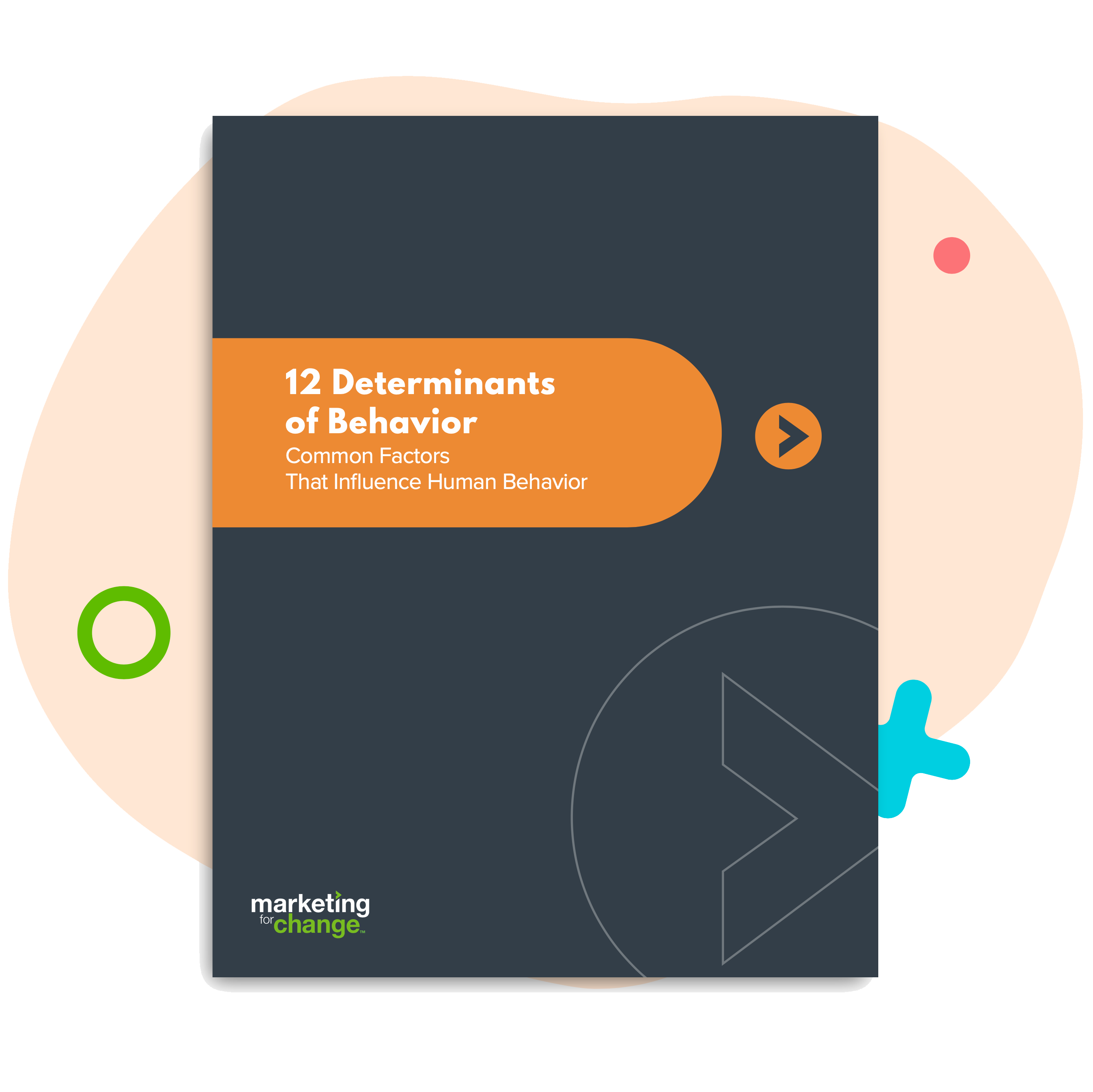
The Science Behind Fun Easy Popular – Here’s What You Need to Know
For 17 years, Marketing for Change has used the shorthand Fun, Easy and Popular to keep our agency laser-focused on the core drivers of behavior change: those wonkily named behavioral determinants that influence what people do.
As behavioral science has evolved, producing new evidence-based determinants like nudges and tiny habits, so has Marketing for Change. Building on the Fun, Easy and Popular approach, we created a Behavioral Determinants Framework that is designed to incorporate new insights while ensuring we can always answer the fundamental behavior change question: Why would real people actually do that?
The Behavioral Determinants Framework incorporates 12 categories of behavioral influences that have been proven to be effective in applied settings (the real world). It also is designed to get around a core problem with market research: if you ask people logical questions, they will give you logical answers. But that kind of logic drives a fraction of human decision-making – and usually only after other influences like values or social identity have been engaged.

Instead, our researchers use questions and techniques designed to surface the behavioral determinants most likely to drive change for a particular audience in a particular context – even if the audience themselves is unaware (like most of us often are) of what is influencing their actions. As a result, our interventions frequently are not aimed directly at problem behaviors, like serving kids sugar-sweetened beverages, but instead are designed to leverage the determinants of those behaviors, such as social norms (most parents like me serve these drinks) and self-standards (this is what makes me a good parent). So, for example, a diabetes intervention may never mention diabetes and a childhood obesity intervention may not talk about weight. With the Behavioral Determinants Framework, we influence the influences of behavior.
A peek at the science that drives what we do
The roots of the Behavioral Determinants Framework go back to a “theories workshop” on the AIDS epidemic hosted by the National Institute of Mental Health in 1991. The participants included some of the biggest names in social psychology – Albert Bandura (social cognitive theory), Marshall Becker (health belief model), Martin Fishbein (theory of reasoned action), Frederick Kanfer (self-regulation model) and Harry Triandis (subjective culture and interpersonal relations).
The three-day workshop ended with a list of eight “variables” that “appear to account for most of the variances in any given behavior.” Susan Middlestadt, a researcher who had worked extensively with the Centers for Disease Control and Prevention and closely with Fishbein, was the meeting’s lead research consultant. She incorporated these variables into her work as the director of the Center for Applied Behavioral and Evaluation Research at the behavior change nonprofit Academy for Educational Development (AED). She and others at AED – including Peter Mitchell, who later went on to found Marketing for Change – began applying these common behavioral determinants into their day-to-day work at AED for the CDC, the Centers for Medicare and Medicaid Services, USAID and others.
Social marketing pioneer Bill Smith, who also worked at AED at the time, coined the phrase Fun, Easy and Popular to remind behavior change campaign designers to incorporate three of the key “variables” identified at the NIH theories workshop: adding rewards (fun), reducing friction (easy) and harnessing social norms (popular). Fun, Easy and Popular wasn’t meant to capture everything. Instead, it was designed to reframe the behavior change conversation away from trying to educate people into change (“they just need to know …”) toward harnessing the power of social psychology.
There are many important components to designing a behavior change campaign, including lessons borrowed from commercial marketing (like the 4 Ps). But in nearly two decades of behavior change work, Marketing for Change has continually found that behavioral determinants are the key ingredient for campaign success. Our Behavioral Determinants Framework, anchored in the experience of practitioners, refines and expands on the original eight “variables” to capture, among other things, the bias and heuristics insights of Daniel Kahneman, Amos Tversky and others in the field of behavioral economics, as well as the social identity work of Dan Kahan, Dominic Packer, Jay Van Bavel and others.
In this way, the Behavioral Determinants Framework is never really a finished product. It is a living framework that is adjusted periodically to incorporate new discoveries in behavioral science.
The Behavioral Determinants Framework in action
Here’s one case study where we used the framework to accomplish the near impossible: reduce purchases of sugary drinks. Many people in public health are (as they should be) alarmed at the twin epidemics of obesity and diabetes, which are impacting Americans starting at younger and younger ages. Sugar-sweetened beverages have been identified as a key cause of excess sugar and calories in American diets, particularly for teens and young adults. But the beverage industry is a powerful opponent. The Rudd Center for Food Policy & Obesity recently documented the industry’s $1.04 billion in annual spending on marketing sugar-sweetened and energy drinks, including a 26% increase in the amount spent to advertise sweetened children’s drinks after major beverage companies pledged to increase marketing of lower-calorie drinks.

For a long time, public health has focused on an information and risk communication approach to get parents (usually mothers, who are most often in charge of household purchases and meals) to stop buying sugary drinks. Campaigns have often tried to use shock and shame, like this one from the U.K. or this truly awful effort by a pediatric hospital in Georgia.
Using the Behavioral Determinants Framework, our research surfaced that that mothers typically knew sugary drinks were unhealthy. But “pick your battles” is sound parenting advice, and this was one hill moms weren’t willing to die on. And like most humans, they were adept at downplaying a risk they didn’t want to worry about. Importantly, most mothers also believed their own household was healthier than average (a sort of Lake Wobegon effect) and that their children were drinking fewer sugary drinks than other kids, even when their household sugary drink consumption was actually higher than the norm.
In our work for the Horizon Foundation in Howard County, Md., we leveraged the behavioral determinants that we learned could move moms to action: community identity, reduced friction and social norms.
First, we used community influencers – real people in the community like sports coaches and preschool teachers – to talk about how they see avoiding sugary drinks as a component of caring for kids.
Second, we reduced friction, making it easier for moms to find a new drink their family might accept. We did this with SwitchTheDrink.com, an online tool that helps match the taste of lower-sugar substitutes to popular sodas and sports drinks. We also added signage in retail locations around the county that pointed shoppers to better beverages.

We then showcased everyday moms who shared tips for cutting back (like mixing juice with water). Lastly, the Foundation built a coalition that helped set standards for serving healthy choices in community settings and accomplished a number of critical policy changes.
Rather than playing up the risks of juvenile diabetes and shaming moms for their drink purchases, we highlighted how other parents and leaders in Howard County were reducing sugar in a community that cares for kids.
The result? A documented 20% drop in sales of sugar sweetened beverages by the third year of the campaign. Now six years in, sales are down an estimated 30%.
That’s the art and the science of our Behavioral Determinants Framework – and making behavior change Fun, Easy and Popular.

Peter is the founder & chief insights officer of Marketing for Change.

Sara Isaac is the agency’s chief strategist.






